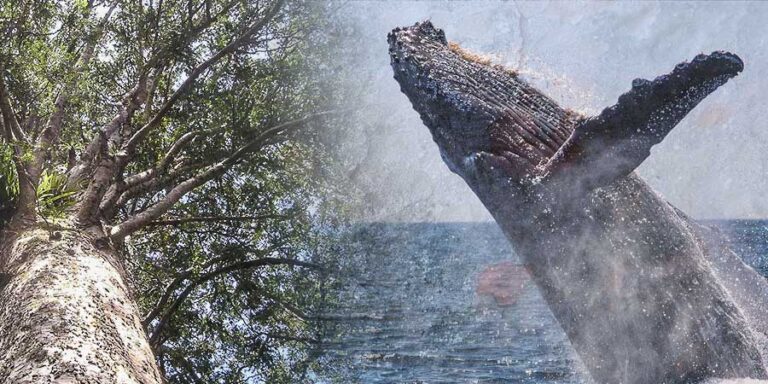There is an ancient Maori legend I heard about when I lived in Aotearoa, New Zealand, about a special connection between the mighty Kauri tree and the Parāoa (sperm whale). Thousands of years ago they were very good friends and before Parāoa returned to live in the sea, Parāoa donated his skin to Kauri for protection. This explains the similarity between the skin of the sperm whale and the bark of Kauri trees and the fact that both produce valuable substances for humans: kauri gum and ambergris. Some say that to this day, when sperm whales come closer to the coast of New Zealand, they sing to the Kauri trees and the trees sing back to them. healthy ecology
Kauri trees are the largest trees in New Zealand and are among the largest in the world. They hold a special place in Maori culture and traditions. Kauri trees have been seriously threatened for some time now by a virus that attacks the roots, making it impossible for the tree to feed properly. The virus is believed to have arrived from abroad about 100 years ago and has spread increasingly through the bush due to growing tourism and trekking activities.
Let me explain.
Sound travels faster and further through water than through air, yet awareness of the level of sound pollution in the oceans is still not very high, at least among the general public. Most people tend to imagine the underwater environment as semi-silent, filled with muffled, gurgling sounds of fish (do they even make sounds?) and underwater currents.
Marine life is much more dependent on sound than sight. In very clear water, close to the surface, the visibility range can reach 70 meters, but this decreases rapidly as one dives deeper. Sound is much more effective in water than light. Fish and marine mammals rely on sound to communicate, find food and navigate, all of which is constantly disrupted when the environment is filled with noise. The barbaric practice of seismic explosions to locate oil deposits consists of producing very loud noise every ten seconds, 24 hours a day for extended periods of time. In the case of New Zealand, for example, seismic blasting has been used in the South Taranaki Bight, and oil companies are trying to get permission to blow up the entire Taranaki Basin, which happens to be the blue whale’s only coastal feeding ground. New Zealand coast. Fortunately, this permission has now been denied by the current government. healthy ecology
Seismic explosions are the most damaging human activities underwater, but the widespread sound of ship and boat engines has become one of the most recurring sounds in Earth’s oceans. Marine biologists who use hydrophones (underwater microphones) for their work often find that this type of noise is virtually ubiquitous. Over the past fifty years, whales have adapted their vocal behavior to adapt to new noise levels. Basically, they shout about the noise we make, in the same way as when we are having a conversation in a busy street or a busy pub.
What if we lived in a world where the whales sang to the trees and the trees sang back to the whale as an important nurturing element of the ecosystem?
What if the sperm whale’s changing song no longer nourishes the Kauri tree as it once did, depriving it of a fortifying nourishment that could potentially make it more resistant to its disease? I think we should start asking ourselves these kinds of questions more often.
Interspecies communication is a recurring theme among indigenous cultures around the world. healthy ecology
This only sounds implausible to the incoherent and narrow-minded mind of post-industrial man, who normally does not display a very sensible relationship with his own environment. But if we dare to venture into the uncharted territory of what was previously known and now forgotten, we may be surprised to discover consistent, meaningful communication between everything and everything else living on this planet. And we would wonder what they say about us and the shamefully loud way we take up our space. healthy ecology
Copyright 2017/24 – Simone Vitale

